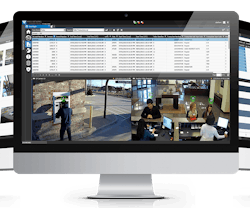Depending on how long you have worked in the physical security industry, you have probably seen your fair share of evolutions in video surveillance technology. Some of us may recall attending security trade shows where attendees could see multiplexers and quads on display along with VCRs and the tapes used to capture thousands of hours of footage — a Herculean effort we have thankfully done away with, thanks to the adoption of digital and networked video.
Other notable shifts in the technology include the ongoing transition from analog to IP video; increasingly advanced video compression; standards-based industry protocols such as ONVIF; the introduction of HD, multi-megapixel and 360 cameras; mobile access to video using smartphones and tablets; cloud-based storage; and, of course, the appearance and advancement of video analytics.
I say advancement because today’s video analytics are more complex than the initial tripwire, camera obstruction and motion detection applications that are now fairly common. While many of the newer generation analytics are still very security-centric, another set is much more business-focused. Rather than triggering a security alarm, these video-based business analytics are designed to provide insights into a business over time to help organizations identify performance trends and areas for improvement. They are tightly integrated with data from other systems, such as retail point-of-sale or banking transaction systems, and they open up an exciting range of applications that extend far beyond security. They also enable organizations to get more value out of the investments already made in video surveillance.
Selling the Benefits of Analytics
For systems integrators and dealers, these business analytics represent an opportunity to provide additional benefit to customers. The first step is being able to paint a clear picture of what today’s analytics can deliver. To help, here are three ways retail and banking organizations can use business analytics to improve their overall performance, profitability and ability to compete.
1. Faster Loss/Fraud Detection and Investigations: Many retailers, banks and credit unions are already using video-based software applications to combine their surveillance video with recorded audio and transaction data. The integrated data and software tools enable faster loss detection and investigation capabilities by enabling users to search on exceptions such as transaction type or amount and click through to the associated video to further review suspicious events. The best applications also allow data searches across all locations simultaneously, further reducing investigation times and costs.
Add video analytics to that mix and the ability to detect potential theft increases dramatically. A dwell time analytic can identify when someone is standing at an ATM for a set time period without conducting a transaction or possibly conducting multiple transactions, which could be indicative of an ATM skimmer installation or cash harvesting. In a retail environment, someone standing in front of a high-value merchandise display for an unusually long period would be worth a quick review of the video. It might be an incident of theft, or possibly a potential customer waiting for assistance. In the case of a theft, the retailer has strong visual evidence to share with law enforcement. If the issue seems to be a lack of customer service, the analytics have helped reveal a gap that can be corrected to directly impact sales at one or multiple stores.
2. Better Customer Service: There’s no question that a positive customer experience is one of the most critical factors when it comes to the success of a retail or retail banking organization. In a 2014 global consumer banking survey conducted by Ernst & Young, consumers said that their experience at a banking branch was the most important consideration when deciding whether to open or close an account — ahead of fees, rates, locations and convenience. Similarly, in response to a 2014 Accenture retail survey, 40 percent of shoppers said that the experience retailers need to improve most was in the store.
Video-driven analytics can help financial institutions and retailers improve customer service, optimize staffing and identify where more training is needed. A people counting analytic married to POS data in an easy-to-use reporting dashboard makes it easy for retailers to determine conversion rates and run site-by-site comparisons. If a certain location is outperforming the rest, staff can quickly review the video to better understand what’s happening and how to emulate the success at other sites.
A queue length monitoring analytic can provide equally useful data, allowing retailers and financial institutions to adjust staffing schedules to reduce customer wait times. Unusually long wait times can also reveal possible training issues, which can be remedied quickly to improve customer service. Studies show that when a customer waits longer than three minutes, their perceived wait time actually multiplies with each passing minute. Video analytics can help organizations pinpoint service issues, resulting in happier, more loyal customers and improved sales.
3. Increased Marketing and Promotional Success: Marketing probably is not a group you think could benefit from surveillance video; however that perspective is changing thanks to integrated analytics and software reporting tools. Using dwell time analytics and POS transaction data, for example, marketers can determine the effectiveness of different retail offers and compare uptake rates across locations. The analytic also enables marketing teams to see how long someone pauses to read a promotion in a bank lobby or lingers in front of a merchandise display in a store. If a display does not seem to be succeeding in a few locations, or is exceeding expectations in others, they can quickly review the video to check how it has been setup or positioned.
Being able to measure the performance of on-site advertising, promotions and merchandising puts marketing teams at a distinct advantage, enabling them to adjust efforts for maximum benefit. Video and business analytics can play a key role by providing valuable insights and metrics, as well as the ability to visually verify that campaigns are rolling out consistently in all locations.
Focused Evolution
Like all relevant technologies, video continues to evolve to provide the capabilities organizations need to work smarter, faster and adopt innovations that contribute directly to their success. Security will, of course, always remain a key application; however, as more organizations recognize the importance of integrating different data sources to gain better insights into their business, video is poised to play a critical role. It is a major source of real-time data that can capture and replay virtually everything that happens in a store or banking branch and provide immediate context to the viewer.
For systems integrators and dealers, it is important to understand what video — and video-based business analytics — can offer beyond core security. Once you have that knowledge in hand, it is time to start engaging with loss and fraud prevention, customer service, operations and marketing decision-makers to help them realize the true value of the video already being captured in their retail and banking locations.
Dan Cremins is the Director of Product Management for March Networks. Request more info about the company at www.securityinfowatch.com/10214308.




